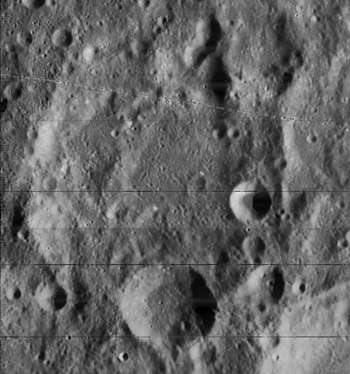Brenner (crater)
 Lunar Orbiter 4 image | |
| Coordinates | 39°00′S 39°18′E / 39.0°S 39.3°ECoordinates: 39°00′S 39°18′E / 39.0°S 39.3°E |
|---|---|
| Diameter | 97 km |
| Depth | 3.3 km |
| Colongitude | 322° at sunrise |
| Eponym | Spiridon Gopčević aka Leo Brenner |
Brenner is an old lunar impact crater that lies in the rugged southeastern part of the Moon's near side. It is named after the Serbian astronomer Spiridon Gopčević (who was also a publicist under the pen name of Leo Brenner) and is located within one crater diameter northwest of the crater pair Metius and Fabricius. Also Janssen is located to the south.
This ancient formation has been deeply eroded by subsequent impacts, to the point where only the western part still resembles a crater. That face has the most intact part of the rim, although it has been worn down until it forms a low ridge in the surface. The northeast part of the crater has been reshaped until it is little more than a rough, irregular part of the terrain. The southeastern rim is overlain by a relatively old crater designated Brenner A.
The crater is actually nearly circular. At this location, from Earth, the crater appears oval due to foreshortening but can rarely be seen, the view from Earth of the crater can only be seen with a telescope.
Satellite craters

By convention these features are identified on lunar maps by placing the letter on the side of the crater midpoint that is closest to Brenner.
| Brenner | Latitude | Longitude | Diameter |
|---|---|---|---|
| A | 40.4° S | 40.0° E | 32 km |
| B | 37.4° S | 41.8° E | 10 km |
| C | 36.5° S | 41.9° E | 7 km |
| D | 36.2° S | 38.7° E | 8 km |
| E | 38.9° S | 40.5° E | 14 km |
| F | 40.6° S | 37.0° E | 14 km |
| H | 36.9° S | 38.7° E | 8 km |
| J | 37.7° S | 36.6° E | 8 km |
| K | 38.0° S | 37.3° E | 7 km |
| L | 38.1° S | 36.6° E | 5 km |
| M | 38.8° S | 36.9° E | 7 km |
| N | 39.0° S | 36.7° E | 7 km |
| P | 38.8° S | 35.3° E | 7 km |
| Q | 39.2° S | 35.9° E | 8 km |
| R | 40.7° S | 38.3° E | 10 km |
| S | 38.4° S | 36.2° E | 6 km |
References
- Andersson, L. E.; Whitaker, E. A. (1982). NASA Catalogue of Lunar Nomenclature. NASA RP-1097.
- Blue, Jennifer (July 25, 2007). "Gazetteer of Planetary Nomenclature". USGS. Retrieved 2007-08-05.
- Bussey, B.; Spudis, P. (2004). The Clementine Atlas of the Moon. New York: Cambridge University Press. ISBN 978-0-521-81528-4.
- Cocks, Elijah E.; Cocks, Josiah C. (1995). Who's Who on the Moon: A Biographical Dictionary of Lunar Nomenclature. Tudor Publishers. ISBN 978-0-936389-27-1.
- McDowell, Jonathan (July 15, 2007). "Lunar Nomenclature". Jonathan's Space Report. Retrieved 2007-10-24.
- Menzel, D. H.; Minnaert, M.; Levin, B.; Dollfus, A.; Bell, B. (1971). "Report on Lunar Nomenclature by the Working Group of Commission 17 of the IAU". Space Science Reviews. 12 (2): 136–186. Bibcode:1971SSRv...12..136M. doi:10.1007/BF00171763.
- Moore, Patrick (2001). On the Moon. Sterling Publishing Co. ISBN 978-0-304-35469-6.
- Price, Fred W. (1988). The Moon Observer's Handbook. Cambridge University Press. ISBN 978-0-521-33500-3.
- Rükl, Antonín (1990). Atlas of the Moon. Kalmbach Books. ISBN 978-0-913135-17-4.
- Webb, Rev. T. W. (1962). Celestial Objects for Common Telescopes (6th revised ed.). Dover. ISBN 978-0-486-20917-3.
- Whitaker, Ewen A. (1999). Mapping and Naming the Moon. Cambridge University Press. ISBN 978-0-521-62248-6.
- Wlasuk, Peter T. (2000). Observing the Moon. Springer. ISBN 978-1-85233-193-1.
| Wikimedia Commons has media related to Brenner (crater). |
